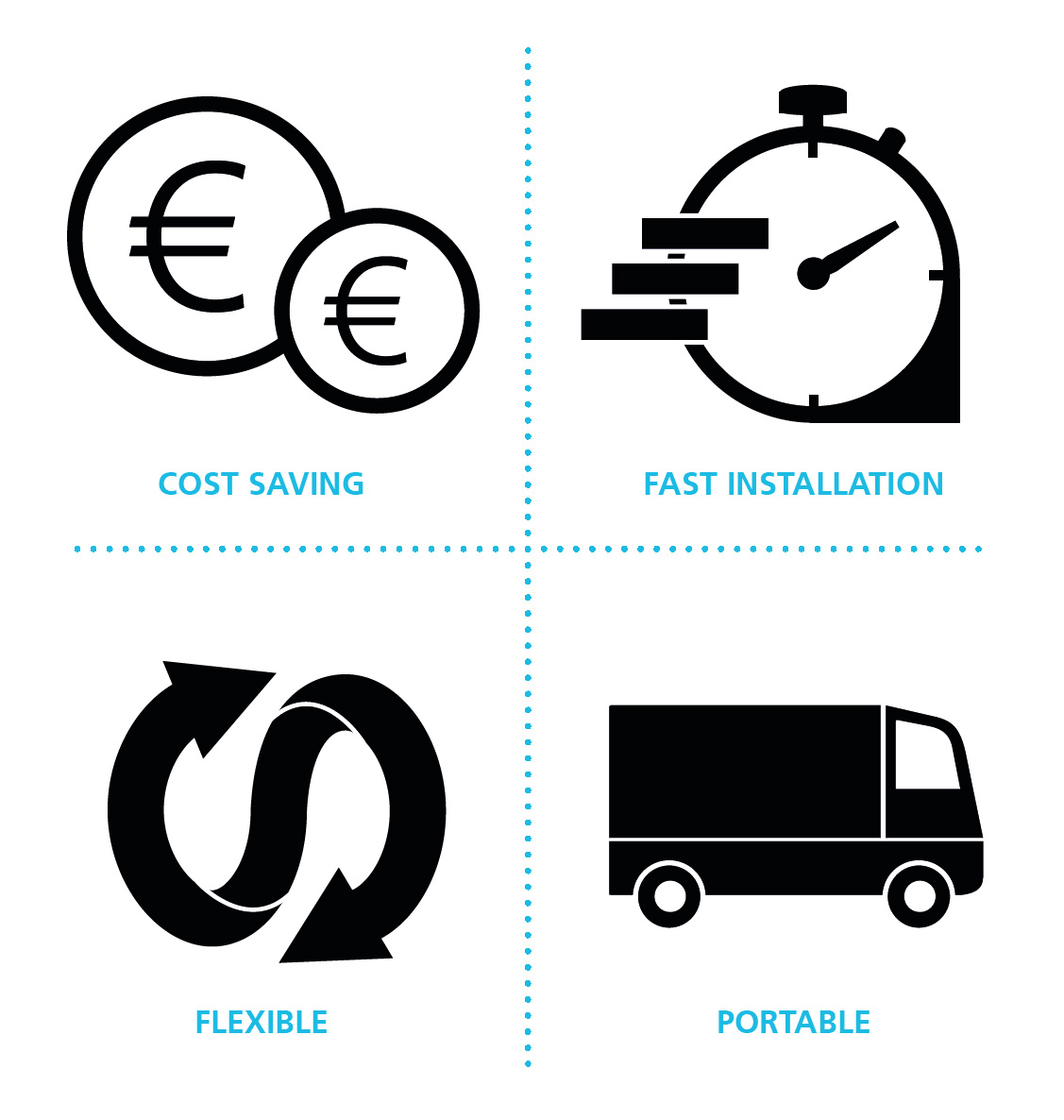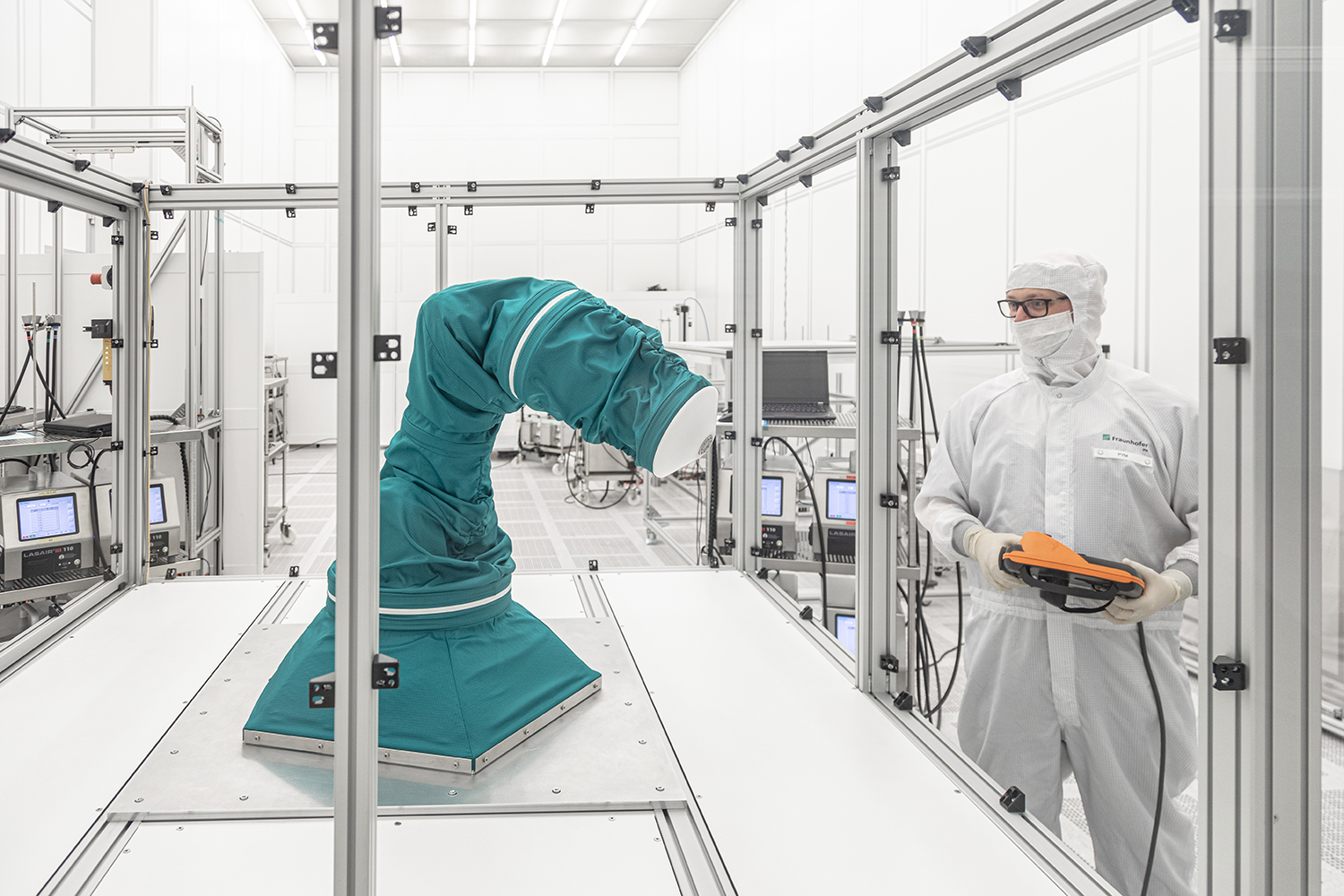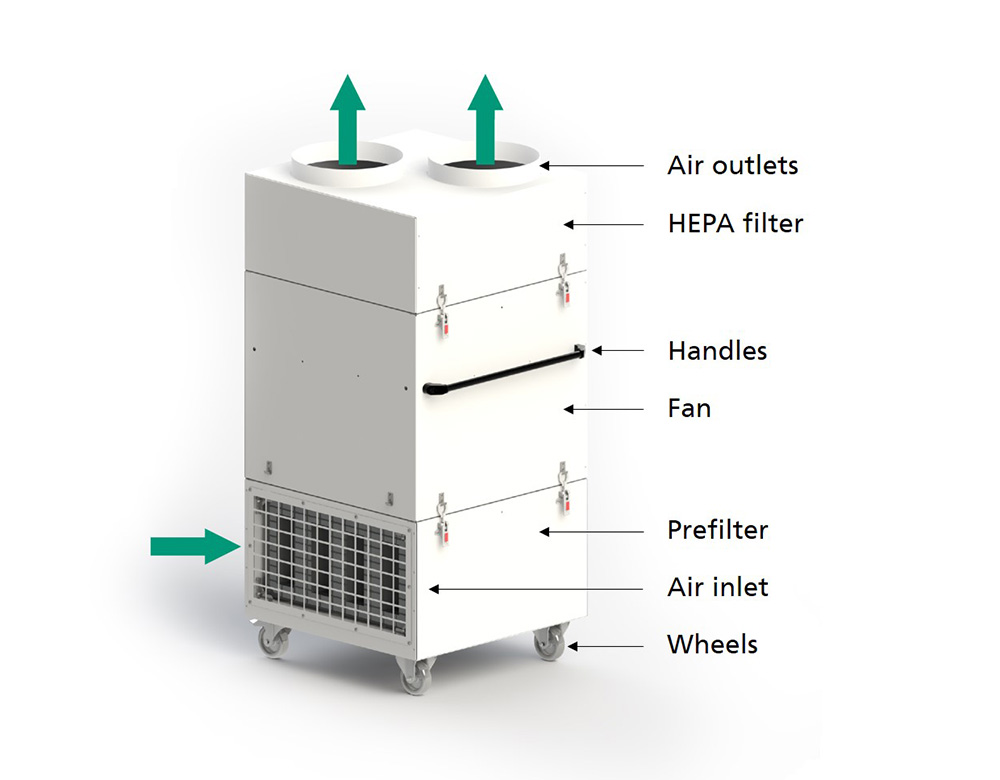
CAPE® – Flexible, Portable Cleanroom System

Problem of airborne contamination
Due to the miniaturization of mechanical and electronic components, which has been continuing for years, processes and products in many industries are reacting more and more sensitively to environmental conditions. Air cleanliness plays an important role. In order to reduce quality problems caused by airborne particles, companies in various high-tech sectors such as the semiconductor industry, the aerospace industry and the pharma industry outsourced contamination-prone manufacturing and assembly processes to cleanrooms at an early stage. Due to long planning and implementation times, the large amount of space required and the long-term occupation of production areas, stationary cleanrooms are not always the best solution.
Mobile cleanroom solutions
With the CAPE®-system (Clean And Protective Environment), scientists at the Fraunhofer IPA have developed a tent-like cleanroom system that can be used to create a cleanroom environment cost-effectively and quickly. It achieves air cleanliness classes similar to those of high quality, conventional cleanrooms, but can be used much more flexibly thanks to its lightweight textile construction.
In order to meet the requirements of different industries and companies, continuous development and individual adaptations of the CAPE®-system are the decisive success factor. This motivation has led to the development of various CAPE®-variants over time.
Tabbed contents
CAPE®
With the »CAPE®« the Fraunhofer IPA has developed a tent-like cleanroom system. Depending on size and configuration, CAPE®-systems can be set up and put into operation within a very short amount of time. Due to the textile construction, the standardized frame system and the reduced need for ventilation technology, the investment costs are significantly lower than those of a conventional cleanroom. Operating costs are only incurred when the system is in use. If the CAPE®-system is no longer required, it can be dismantled and stored or transported to another location.
The size and shape of the respective CAPE®-system can be individually adapted to customer requirements. For example, a portable 2 x 2 x 2 m »CAPE®« is particularly suitable for shielding individual workstations, manufacturing processes or laboratory operations, while a 10 x 10 x 5 m system is suitable for shielding entire manufacturing and assembly systems or for assembling larger systems under cleanroom conditions. Serveral CAPE®-systems of different sizes with different pressure ratios can also be combined and used in zone operation.
Quarantine-CAPE®
In the event of a pandemic, it is particularly important to act quickly and locally. The separation of healthy and infected persons is crucial, which cannot be ensured by quarantine mass storage facilities. One solution provides the one-person quarantine system »Quarantine-CAPE®«.
- Suitable for decentralised application in the event of a pandemic, can be flexibly expanded and combined
- The protective effect is achieved through a flow-permeable, textile multi-layer system for a tent-like room boundary made of sterilizable and decontaminable materials
- Tridirectional barrier effect: (1) protection of a quarantined patient in the interior against microbiologically contaminated outside air, (2) protection of persons in the surrounding area and (3) prevention of contamination carry-over between interior and exterior
- Quick assembly/disassembly and commissioning within a few minutes
- Ensuring sterile, microbiologically contamination-free supply air, circulating air and exhaust air
- Low purchase and operating costs
Maintenance-CAPE®
In existing, stationary cleanrooms, maintenance and repairs must be carried out over time. During this process, the ultra clean ambient air is contaminated by the smallest particles and chemical impurities. These contaminants are deposited on production equipment in the clean room environment and thus slow down the regeneration of the cleanroom after the repairs have been completed. In order to shorten necessary production downtimes, scientists from the department ultraclean technology and micromanufacturing at Fraunhofer IPA have developed the »Maintenance-CAPE®«.
- Innovative maintenance system for stationary cleanrooms
- Spatial delimitation and removal of contaminations resulting from maintenance work or repairs
- Integration into existing systems by installing a rail system (on the ceiling)
Variable positioning through movable frame - User-friendly system: For commissioning, the frame is lowered, textile webs are hung on the floor level and subsequently the frame is pulled up again
- Space-saving construction
FastBuild-CAPE®
The new »FastBuild-CAPE®« was developed to create an ultraclean environment in the shortest possible time. Unlike the original CAPE®-system, the frame of the new cleanroom tent is airborne. The construction consists of special, air-tight hoses and can be set up within a few minutes with compressed air via a valve. A filter fan unit is then connected for commissioning.
- Set up and ready for use within a few minutes
- Installation by one person possible
- No solid base necessary for assembly
- Easy to clean and store
- Very low weight and packing size
Hygienic-CAPE®
In life science industries such as the pharmaceutical, medical and food industries, the concept of hygiene is traditionally strongly established. In addition to particles, especially biological contaminations are considered critical for production. In the attachment of the regulations of the "Good Manufacturing Practice" (GMP) all requirements for the cleanliness classes A/B, C and D are described.
To meet the GMP requirements, additional criteria such as chemical and biological resistance, antibacterial effectiveness and cleanability must be taken into account. These criteria can only be met by suitable materials, hygienic design, thermodynamic air treatment, ventilation technology, air lock systems and a monitoring system.

The Hygienic-CAPE® offers a fast and flexible solution for clean production environments in the life science sector.
- GMP-compliant clean room tent
- Special surface made of foil:
- (1) Easy to clean and disinfect
- (2) Chemical resistance
- (3) Low outgassing and antistatic
- Stable, corrosion-resistant stainless steel base frame outside the CAPE® shell
- Hygienically adapted construction and connecting elements
- Air treatment by means of HEPA filters
- Optional air conditioning
- Airlock systems with pressure cascades
- Lighting according to requirements
2ndSCIN®
The use of standard industrial components in a cleanroom environment is challenging. Particles or chemical and biological residues released by the equipment are particularly problematic. Since it is not always possible to enclose the source of contamination with a tent system, 2ndSCIN® was developed. It is a breathable, textile protective cover that can be individually adapted to dynamic automation components.
You can find further information here.
The CAPE® in detail
Function
The CAPE® system works similar to a stationary cleanroom.
The ambient air, which is rich in particles, e.g. in an assembly hall, is sucked in via a Filter Fan Unit (FFU) and filtered for coarse fine dust and finest suspended particles via a two-stage filter system. The particle-free clean air is then fed through a hose system into the ceiling plenum of the CAPE®-system. The air continues to flow through the bottom of the plenum into the interior of the CAPE®-system. The uniform air flow through the plenum results in a low-turbulence displacement flow in the CAPE® interior. This then escapes through the walls and openings in the floor area.
Vacuum and circulating air function
CAPE®-System in vacuum modeOperation in vacuum mode is required when sensitive environments are to be protected from particle emitting measures such as maintenance work. The functionality of the air system is reversed. The intake side of the FFU unit is connected to the interior of the CAPE®-system. The FFU unit then sucks the contaminated air from the CAPE® interior, filters it and discharges it directly into the environment.
CAPE®-System with circulating air functionIn addition to overpressure and vacuum operation, recirculation operation is also possible to increase the efficiency of the filtration. Similar to the vacuum function, the CAPE®-system sucks in and filters the interior air and then directs it through the textile air system as a directed flow over the ceiling area into the CAPE® interior.
Ultraclean air supply
A Filter Fan Unit (FFU) is used to supply the CAPE®-system with ultraclean air. This ensures air exchange, overpressure in the system and filtration of contaminated air.
The integrated fans transport the air through the various filter systems to produce the ultraclean air. Using an uptake hose attached to the discharge port of the FFU, the ultraclean air can be transported to the desired locations.
Multiple parallel operated FFU-units.The standard FFU units can be operated with a standard 230V connection and are capable of generating a volume flow of up to 3000m³/h. Due to the modular use of selectable pre-filters and main filters, different filter classes up to ISO 1 can be realized and efficiently regulated.
Depending on the size and air cleanliness class of the CAPE®-system, several FFU units are operated in parallel.
Cleanroom suitable textiles
The high air cleanliness classes of the CAPE®-system are achieved not only by the innovative air guidance system but also by the use of special cleanroom-suitable textiles. The special textiles are characterised by very low particle emission, high particle retention capacity, good electrostatic dissipation capacity and low emission of chemical gaseous substances. These characteristics make it possible to use the CAPE®-system within stationary cleanrooms, e.g. to locally generate a higher air cleanliness class or to protect a cleanroom from processes with a high risk of contamination.
Prices and delivery times
The price of the CAPE®-systems depends on the size, the required air cleanliness class and any special customer-specific solutions. Small, simple variants of the CAPE®-system are available for less than 10,000 €.
Delivery times for the purchase options are between 3 and 6 months, depending on the order situation. In the case of a time-limited provision, it is also possible to react more quickly to requests, depending on availability.
The CAPE®
Setup and commissioning of the CAPE®-system


